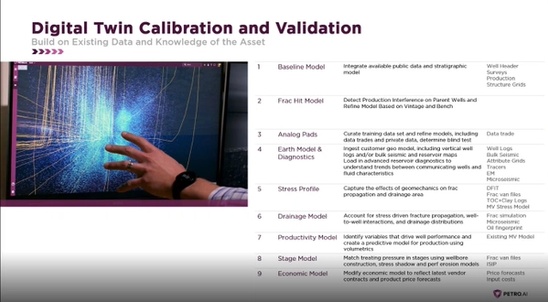Q: Does Petro.ai have a data driven software that can help predict well performance using time series predictions within the geological parameters of spacing and lateral completions and production for unconventionals? Does this software allow for running sensitivity analysis on 3D spacing lateral and interval values?
A:Kyle LaMotta, VP of Analytics responds, “Petro.ai focuses 100% on unconventionals. And we do incorporate all these different aspects. We consider the geology. We can incorporate reservoir characteristics. We include the structure grid that the operator has. We build a 3D Earth Model that incorporates all the geological and geophysical data types as well as the geomechanics which means the stress in the area which is measured from different diagnostics like DFits, ISIPs, and geomechanical stress logs.

“Petro.ai builds a full 3D geophysical, geological earth model. Once we have that, Petro.ai interrogates that earth model using the offset or existing well data. Based on the wells in each area, we’re considering the exact well location, the relationships of the parent, child, and sibling wells so we can calculate the well spacing for all the wells. We can further calculate the drainage for those wells that have been produced. Once we’ve built these models we can interrogate them and run sensitivities.
“By training the model with all this data, and honoring the physics and geomechanics of the area, we can run sensitivities on well spacing, lateral length, interval placement. Let’s say you’re designing a pad and you’ve got 10 different spacing considerations and 3 different landing positions and you want to develop 2 or 3 different benches.
“Petro.ai can develop for that one pad, hundreds of thousands of different potential well locations and potential well and completion designs. Then we’ll predict a full time series for oil and gas for each one of those wells. This way you can look at the tradeoffs between the well spacing and production, well spacing and economics, interval placement, production and economics. You can optimize on any of those parameters. You can optimize on early life production, later life production, EURs, NPVs, rate of returns, any of the economic parameters.You can sort and filter and figure out which of the sensitivities that’s maximizing the parameter most important to you.

“Petro.ai starts with a baseline model, to get something in our clients’ hands quickly and to establish an accuracy that serves as a benchmark. As we start adding in additional data types like considering the geomechanics and considering different properties such as the frac geometry models, then we start to see what the value of the information is for each one of those in different steps of the analysis.
“If we add in a stress log and the accuracy jumps up 10%, then we know that the stress log is adding quite a bit, 10% of accuracy. We start with the base line and that establishes a benchmark and we’re always trying to improve it from there.
“The client feedback comes in on the different sensitivities that they want to run. A client may know how many wells they want to drill but we’ve got some flexibility on the exact location of those wells.“ The client may say, here’s our design that we’re thinking of right now, but what happens if we move these wells over 100 feet, up or down 100 feet, how does that change things? Petro.ai can run all those options.
“If you’ve got some time to plan, you can ask questions like, should we do 6 or 4 wells? We’re also considering adding another interval which is going to add a significant capital increase but we want to know if that’s justified by the economics. That’s a different type of sensitivity where we’re changing the number of the wells in the pad and we’re also changing where those wells are being drilled.
“The process is consistently interactive and collaborative. We meet with clients once a week, get feedback on the results and incorporate that back into the analysis.”




